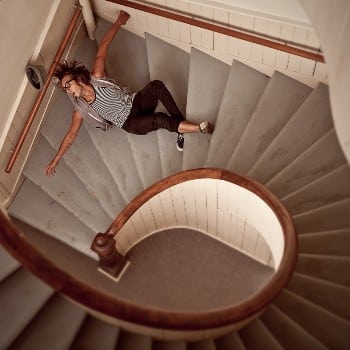The Importance Of Railings For Slip And Fall Safety

The National Safety Council (NSC) has found that over 1 million people suffer injuries from falls on stairs on an annual basis in the United States. Not only that, an estimated 12,000 of those who fall do not survive their injuries. Chances are that even if the person recovers they could face a long road to recovery or even a permanent disability due to the serious potential injuries that may have occurred. This is one of the reasons that railings are required on any set of stairs whether in a public or private area. How much attention have you paid to them lately?
How Railings Stop Slip and Falls
Have you ever walked up or down a set of stairs and stumbled? Pretty much everyone has done this at least a few times in their life. For most, it’s not a big deal. You might simply stub your toe on the step above you or stumble a couple of steps. Unfortunately, it’s entirely possible that you can get seriously injured on stairs for a variety of reasons:
- Snow/ice/water on the steps
- Other objects on the steps
- Improper railings
The truth of the matter is that even if something is on the steps, you can often protect yourself from major injury as long as the railings are appropriate. After all, your first instinct, if you slip, trip, or fall while on a set of stairs, is to grab the railing, is it not? And yet, what if the railing isn’t secure or isn’t even present?
Keeping Railings Safe
If the railing you reach for isn’t secure it could give way from its foundation and cause you to lose your balance and fall, ultimately suffering a grave injury. Consider also that stairs are inherently dangerous given that, if you fall at the top, you may not stop until you’ve reached the bottom.
An even worse scenario, and one which is surprisingly common in its regularity, is an instance in which a person falls over the side of the stairs in an attempt to regain their balance. As you can imagine, potential results are nothing short of disastrous, even to the extent where suffering a wrist fracture in a slip and fall can seem like a markedly positive outcome.
This is why it is incredibly important to keep any railings that you are responsible for (such as those on front and back porches and interior stairs) properly secured for any who may use them.
Understanding Railings
There are several different types of railings if you want to get really technical. These include:
- Guardrails
- Stair rails
- Handrails
Each has a slightly different look and a slightly different purpose. First, guardrails are present where there is an area leading to a lower level. If you had a landing next to the stairs to another floor, for example, which was not blocked by a wall you would put up a guardrail to ensure no one fell over the side of the floor.
A stair rail is the typical railing you probably thought of when you started reading this article. It’s the railing that is
on the side of a set of stairs and provides you something to hold onto while you are walking down. It’s generally at least waist high on an adult to ensure that you do not easily fall over the side of the railing as you are ascending or descending the stairs.
Finally, a handrail is often similar to a stair rail and may be used in conjunction with one. If you are walking up a ramp or staircase you may see a rail slightly below the top of the regular railing. This is what’s actually intended to help you walk up and down those stairs (though many people use the stair rail to do so). They are often present on ramps as well and may be posted onto stair rails or even on walls to make walking easier.
Faced With Poor Railings Injuries
If you have been the victim of improperly installed railings of any type you are entitled to damages from this. It is the responsibility of stores, governments, landlords and property owners to keep all railings properly secured and attached so that you don’t have to worry about injury if you need to use them.
